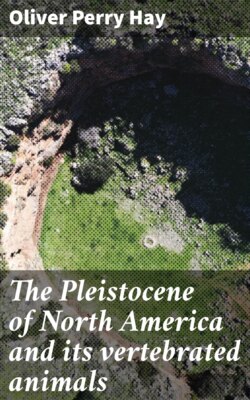Читать книгу The Pleistocene of North America and its vertebrated animals - Oliver Perry Hay - Страница 72
На сайте Литреса книга снята с продажи.
Mastodons Found Between the Shelbyville and the Bloomington Moraines.
Оглавление13. Greencastle, Putnam County.—The State collection at Indianapolis contains a last molar of a mastodon found somewhere near Greencastle. It is not known whether it was found on Wisconsin drift or on Illinoian, or in Wisconsin outwash along Eel River.
50. Greensburg, Decatur County.—From Dr. W. D. Matthew, American Museum Natural History, New York City, the writer has received information, accompanied by drawings, that teeth and part of the jaw of a mastodon were found near Greensburg, by Mr. Roscoe Humphrey. The drawings show two teeth, one having a length of 102 mm., the other of 135 mm. Mr. Humphrey states that the jaw and the teeth were found in a branch of Sand Creek, about 4.5 miles southeast of Greensburg. This is evidently on the Shelbyville moraine.
14. Danville, Hendricks County.—The collection of the State Museum at Indianapolis contains a lower second true molar labeled as having been found near Danville. The specimen is credited to Dr. Vinnage. As this region is covered by Wisconsin drift, it is probable that the animal lived after the Wisconsin ice had retired.
15. Attica, Fountain County.—Mr. J. E. Walker, of Attica, Indiana, has informed the writer that about October 1, 1895, a mastodon jaw was found near Newtown, in that county. Mr. Charles B. McKinney, of Newtown, wrote that the jaw was discovered in the bank of Coal Creek, about 4 rods from where the creek crosses into Montgomery County, in the northeast quarter of section 9, township 20 north, range 6 west. The bank rose 3 feet above the bed of the creek and was composed of a black loam; higher ground is found about 20 rods away. This jaw must have been buried originally where it was found or nearby and after the ice which formed the Champaign moraine had withdrawn further north. It may have been long after this withdrawal. The description of the jaw and teeth leaves no doubt as to the correct identification of the animal.
Former State Geologist John Collett, in 1880 (2nd Rep. Bur. Stat. Geol. Indiana, p. 386), stated that in digging a canal a few miles north of Covington a skeleton of a mastodon had been found embedded in wet peat. Collett reported that the bones yet contained their marrow. The identity of the species and the details as to location and depths are not given. Doubtless the age of the animal was Late Wisconsin.
